 W
WByzantine art comprises the body of Christian Greek artistic products of the Eastern Roman (Byzantine) Empire, as well as the nations and states that inherited culturally from the empire. Though the empire itself emerged from the decline of Rome and lasted until the Fall of Constantinople in 1453, the start date of the Byzantine period is rather clearer in art history than in political history, if still imprecise. Many Eastern Orthodox states in Eastern Europe, as well as to some degree the Islamic states of the eastern Mediterranean, preserved many aspects of the empire's culture and art for centuries afterward.
 W
WByzantine illuminated manuscripts were produced across the Byzantine Empire, some in monasteries but others in imperial or commercial workshops. Religious images or icons were made in Byzantine art in many different media: mosaics, paintings, small statues and illuminated manuscripts. Monasteries produced many of the illuminated manuscripts devoted to religious works using the illustrations to highlight specific parts of text, a saints' martyrdom for example, while others were used for devotional purposes similar to icons. These religious manuscripts were most commissioned by patrons and were used for private worship but also gifted to churches to be used in services.
 W
WThe Aachen Gospels are a Carolingian illuminated manuscript which was created at the beginning of the ninth century by a member of the Ada School. The Evangeliary belongs to a manuscript group which is referred to as the Ada Group or Group of the Vienna Coronation Gospels. It is part of the church treasury of Charlemagne's Palatine Chapel, now Aachen Cathedral, and is today kept in the Aachen Cathedral Treasury. The Treasury Gospels and the more recent Ottonian Liuthar Gospels are the two most significant medieval manuscripts on display there.
 W
WThe Agate Bowl is a hardstone carving in the shape of a bowl cut out of a single piece of agate, possibly in the fourth century at the court of Constantine, and now displayed in the Imperial Treasury at the Hofburg Palace in Vienna, Austria. For centuries it was widely regarded as the "greatest masterpiece" and the "best and most important piece" in the collection. In 1564, Holy Roman Emperor Maximillian II and his brothers declared it by deed to be an "inalienable heirloom of the house of Austria". They valued this ancient precious stone carving, not just for its craftsmanship, but for a "natural miracle" in the stone itself that reveals a mysterious inscription—the name XRISTO (Christ) at the bottom of the bowl within the grain of the stone. It is now generally believed that the inscription inspired the legend that the bowl was the Holy Grail. The Agate Bowl is the largest carved stone bowl in the world.
 W
WArt of Eternity is a series of 3 1-hour documentaries on Christian art presented by Andrew Graham-Dixon. It was first broadcast on BBC Four in 2007, and later repeated on BBC Two.
 W
WThe Asyut Treasure is the name of an important Byzantine hoard of jewellery found near the city of Asyut, central Egypt. Discovered in mysterious circumstances in the early twentieth century, the treasure is now divided between the Kunstgewerbemuseum in Berlin, the British Museum in London and the Metropolitan Museum in New York City.
 W
WThe Basilica of Sant' Apollinare in Classe is a church in Ravenna, Italy, consecrated on 9 May 549 by the bishop Maximian and dedicated to Saint Apollinaris, the first bishop of Ravenna and Classe. An important monument of Byzantine art, in 1996 it was inscribed with seven other nearby monuments in the UNESCO World Heritage List, which described it as "an outstanding example of the early Christian basilica in its purity and simplicity of its design and use of space and in the sumptuous nature of its decoration".
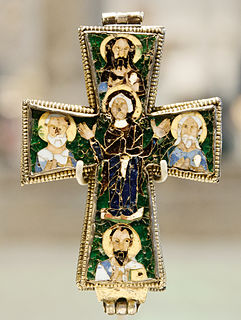 W
WThe Beresford Hope Cross is a 9th-century Byzantine reliquary cross with cloisonné enameling. It was intended to be worn as a pectoral crucifix, perhaps holding a fragment of the True Cross in the compartment inside. The cross is thought to have been made in southern Italy around the end of Byzantine iconoclasm, between 843 and the mid tenth century. It has been held by the Victoria and Albert Museum since 1886.
 W
WByzantine blue is a color ranging from light celestial blue or lazuli to dark Egyptian blue.
 W
WThe Byzantine Fresco Chapel is a part of the Menil Collection in Houston, Texas, near the University of St. Thomas. From February 1997 to February 2012, it displayed the only intact Byzantine frescoes of this size and importance in the entire western hemisphere. The Byzantine frescoes had been taken from the church of St. Evphemianos in Lysi, Cyprus in the 1980s. In September 2011, the collection announced that the frescos would be permanently returned to Cyprus in February 2012, following the conclusion of a long-term loan agreement with the Greek Orthodox Church of Cyprus. The frescoes had been presented at the museum by agreement with the Church of Cyprus, their owners, but the church decided not to extend the loan further. They will not return to their original home as Lysi is now in Northern Cyprus, but will be displayed at the Byzantine Museum in Nicosia. On March 4, 2012, the Byzantine Fresco Chapel closed, but re-opened in 2015 for the first in a series of site-specific projects.
 W
WThe Byzantine Museum of Kastoria is a museum in Kastoria in Greece, dedicated to religious art from the area's late Byzantine and post-Byzantine periods.
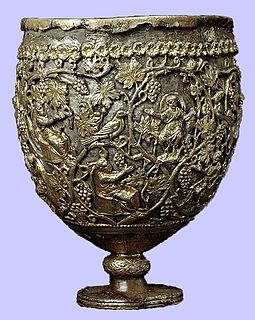 W
WSilver was important in Byzantine society as it was the most precious metal right after gold. Byzantine silver was prized in both the secular and domestic realms. Aristocratic homes had silver dining ware, and in churches silver was used for crosses, liturgical vessels such as the patens and chalices required for every Eucharist. Silver was also used as a medium in pagan mythological scenes and objects such as the Sevso Treasure. Silver pieces, especially silverware, continued to be rendered in the classical style into the seventh century.
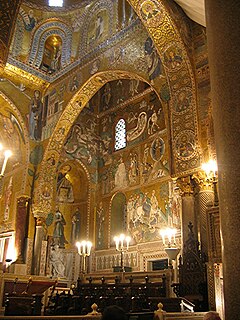 W
WThe Palatine Chapel, is the royal chapel of the Norman palace in Palermo, Sicily. This building is a mixture of Byzantine, Norman and Fatimid architectural styles, showing the tricultural state of Sicily during the 12th century after Roger II's father and uncle conquered the island.
 W
WCastelseprio was the site of a Roman fort in antiquity, and a significant Lombard town in the early Middle Ages, before being destroyed and abandoned in 1287. It is today preserved as an archaeological park in the modern comune of Castelseprio, near the modern village of the same name. It is in the north of Italy, in the Province of Varese, about 50 km northwest of Milan.
 W
WThe Cathedral of Cefalù is a Roman Catholic basilica in Cefalù, Sicily. It is one of nine structures included in the UNESCO World Heritage Site known as Arab-Norman Palermo and the Cathedral Churches of Cefalù and Monreale.
 W
WThe Kariye Mosque, or the Church of the Holy Saviour in Chora, is a medieval Greek Orthodox church used as a mosque today in the Edirnekapı neighborhood of Istanbul, Turkey. The neighborhood is situated in the western part of the municipality (belediye) of the Fatih district. The Church of the Holy Saviour in Chora was built in the style of Byzantine architecture. In the 16th century, during the Ottoman era, the Christian church was converted into a mosque; it became a museum in 1945, and was turned back into a mosque in 2020 by President Erdogan but the mosque reversion has been halted as of January 2021 due to lack of Islamic cultural significance and clerical interest, compared to the Hagia Sophia. The interior of the building is covered with some of the oldest and finest surviving Byzantine Christian mosaics and frescoes; they were uncovered and restored after the building was secularized and turned into a museum.
 W
WChrist in Majesty or Christ in Glory is the Western Christian image of Christ seated on a throne as ruler of the world, always seen frontally in the centre of the composition, and often flanked by other sacred figures, whose membership changes over time and according to the context. The image develops from Early Christian art, as a depiction of the Heavenly throne as described in 1 Enoch, Daniel 7, and The Apocalypse of John. In the Byzantine world, the image developed slightly differently into the half-length Christ Pantocrator, "Christ, Ruler of All", a usually unaccompanied figure, and the Deesis, where a full-length enthroned Christ is entreated by Mary and St. John the Baptist, and often other figures. In the West, the evolving composition remains very consistent within each period until the Renaissance, and then remains important until the end of the Baroque, in which the image is ordinarily transported to the sky.
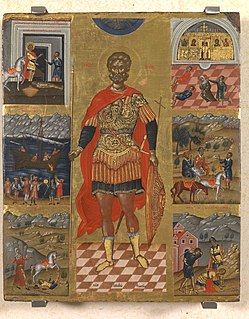 W
WCretan School describes an important school of icon painting, under the umbrella of post-Byzantine art, which flourished while Crete was under Venetian rule during the late Middle Ages, reaching its climax after the Fall of Constantinople, becoming the central force in Greek painting during the 15th, 16th and 17th centuries. The Cretan artists developed a particular style of painting under the influence of both Eastern and Western artistic traditions and movements; the most famous product of the school, El Greco, was the most successful of the many artists who tried to build a career in Western Europe, and also the one who left the Byzantine style farthest behind him in his later career.
 W
WThe Cross of Justin II is a processional cross dating from the sixth century that is kept in the Treasury in St. Peter's Basilica, in Vatican City. It is also one of the oldest surviving claimed reliquaries of the True Cross, if not the oldest. It is a crux gemmata or jewelled cross, silver-gilt and adorned with jewels in gold settings, given to the people of Rome by the Emperor of the Eastern Roman (Byzantine) Empire, Justin II, who reigned from 565 to 578 in Constantinople, and his co-ruler and wife, the Empress Sophia.
 W
WDaphni or Dafni is an eleventh-century Byzantine monastery eleven kilometers northwest of central Athens in the suburb of Chaidari, south of Athinon Avenue (GR-8A). It is situated near the forest of the same name, on the Sacred Way that led to Eleusis. The forest covers about 18 km2 (7 sq mi), and surrounds a laurel grove. "Daphni" is the modern Greek name that means "laurel grove", derived from Daphneion (Lauretum).
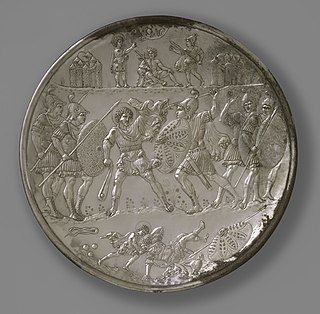 W
WThe David Plates are a set of nine silver plates, in three sizes, stamped between 613 and 630. The plates were created in Constantinople, each depicting a scene from the life of the Hebrew king David, and associated with the reign of Emperor Heraclius (610-641). Following their discovery in Karavas in 1902, the David Plates have been considered key additions to early Byzantine secular art. It is also noted that the David Plates were found amongst the Second Cyprus Treasure. Casual laborers from the village of Karavas found the David Plates as they were quarrying the ruins for construction stones. The finders, however, failed to report what they had discovered to the Cypriot authorities. When authorities learned of their taking they confiscated three of the David Plates alongside a pair of cross-monogram plates, and other jewelry held today in the Museum of Antiquities in Nicosia. The rest of the discovery was smuggled from Cyprus and traded to a dealer located in Paris. Most of this hoard was bought by J. Pierpont Morgan and was later given to the Metropolitan Museum of Art in New York City by his heirs in 1917, where they currently remain.
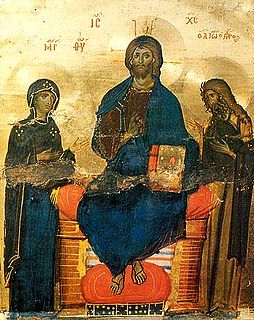 W
WIn Byzantine art, and later Eastern Orthodox art generally, the Deësis or Deisis, is a traditional iconic representation of Christ in Majesty or Christ Pantocrator: enthroned, carrying a book, and flanked by the Virgin Mary and St. John the Baptist, and sometimes other saints and angels. Mary and John, and any other figures, are shown facing towards Christ with their hands raised in supplication on behalf of humanity.
 W
WThe Eleusa is a type of depiction of the Virgin Mary in icons in which the infant Jesus Christ is nestled against her cheek. In the Western church the type is often known as the Virgin of Tenderness.
 W
WThe craft of cloisonné enameling is a metal and glass-working tradition practiced in the Byzantine Empire from the 6th to the 12th century AD. The Byzantines perfected an intricate form of vitreous enameling, allowing the illustration of small, detailed, iconographic portraits.
 W
WThe Fieschi Morgan Staurotheke is a small reliquary designed to hold a relic of the true cross, it is 1 1/16 x 4 1/16 x 2 13/16 inches overall with lid. It is an example of Byzantine enameling. The box is dated to 843. Both dates hover around the second wave of Byzantine Iconoclasm from 814 to 842, allowing this piece to become a lens into the post iconoclastic art. These reliquaries doubled as an icon in style and purpose. The physical material of icons and the content within the reliquary were believed to contained a spirit or energy. It was believed that reliquaries contained great power, thus explains its preservation throughout the years. There are numerous theories of where this piece was created and its movement. It's currently on display at the Metropolitan Museum.
 W
WThe First Cyprus Treasure or Lamboussa Treasure is the name of a major early Byzantine silver hoard found near Kyrenia, Cyprus. Currently in the British Museum's collection, the treasure is largely composed of liturgical objects that may have belonged to an ancient church or monastery. It is called the First Cyprus Treasure to distinguish it from the so-called Second Cyprus Treasure, which is now split between the Metropolitan Museum of Art and the Cyprus Museum.
 W
WGold ground or gold-ground (adjective) is a term in art history for a style of images with all or most of the background in a solid gold colour. Historically, real gold leaf has normally been used, giving a luxurious appearance. The style has been used in several periods and places, but is especially associated with Byzantine and medieval art in mosaic, illuminated manuscripts and panel paintings, where it was for many centuries the dominant style for some types of images, such as icons. For three-dimensional objects, the term is gilded or gold-plated.
 W
WThe Gunthertuch is a Byzantine silk tapestry which represents the triumphal return of a Byzantine Emperor from a victorious campaign. The piece was purchased, or possibly received as a gift, by Gunther von Bamberg, Bishop of Bamberg, during his 1064–65 pilgrimage to the Holy Land. Gunther died on his return journey, and was buried with it in the Bamberg Cathedral. The fabric was rediscovered in 1830, and is now exhibited in the Bamberg Diocesan Museum.
 W
WHagia Sophia is a formerly Greek Orthodox church which was converted into a mosque in 1584, and located in Trabzon, in the north-eastern part of Turkey. It was converted into a museum in 1964 and back into a mosque in 2013. It dates back to the thirteenth century when Trabzon was the capital of the Empire of Trebizond. It is located near the seashore and two miles west of the medieval town's limits. It is one of a few dozen Byzantine sites extant in the area. It has been described as being "regarded as one of the finest examples of Byzantine architecture."
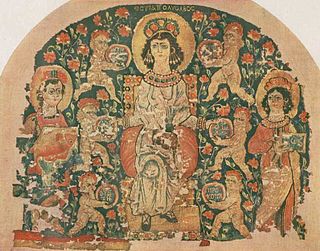 W
WThe Hestia tapestry is a Byzantine-era pagan tapestry made in the Diocese of Egypt in the first half of the 6th century. It is now in the Dumbarton Oaks Collection in Washington DC, but generally not on display.
 W
WThe Hetoimasia, Etimasia, prepared throne, Preparation of the Throne, ready throne or Throne of the Second Coming is the Christian version of the symbolic subject of the empty throne found in the art of the ancient world, whose meaning has changed over the centuries. In Ancient Greece it represented Zeus, chief of the gods, and in early Buddhist art it represented the Buddha. In Early Christian art and Early Medieval art it is found in both the East and Western churches, and represents either Christ, or sometimes God the Father as part of the Trinity. In the Middle Byzantine period, from about 1000, it came to represent more specifically the throne prepared for the Second Coming of Christ, a meaning it has retained in Eastern Orthodox art to the present.
 W
WThe history of painting reaches back in time to artifacts from pre-historic humans, and spans all cultures. It represents a continuous, though periodically disrupted, tradition from Antiquity. Across cultures, and spanning continents and millennia, the history of painting is an ongoing river of creativity, that continues into the 21st century. Until the early 20th century it relied primarily on representational, religious and classical motifs, after which time more purely abstract and conceptual approaches gained favor.
 W
WThe Holy Crown of Hungary, also known as the Crown of Saint Stephen, was the coronation crown used by the Kingdom of Hungary for most of its existence; kings have been crowned with it since the twelfth century. The Crown was bound to the Lands of the Hungarian Crown. No king of Hungary was regarded as having been truly legitimate without being crowned with it. In the history of Hungary, more than fifty kings were crowned with it, up to the last, Charles IV, in 1916. The only kings who were not so crowned were Wladyslaw I, John Zápolya, John Sigismund Zápolya and Joseph II.
 W
WThe Kaper Koraon Treasure is a Byzantine silver treasure consisting of 56 individual silver items originating from Syria in the sixth and seventh centuries.
 W
WThe Klimova Treasure is a hoard of Early Byzantine and Sasanian silver objects that was discovered in 1907 near the village of Klimova in the Perm Governorate of the Russian Empire. It is one of several hoards of Byzantine and Sasanian silverware uncovered in that region, which are collectively referred to as the Perm Treasures.
 W
WThe Lampsacus Treasure or Lapseki Treasure is the name of an important early Byzantine silver hoard found near the town of Lapseki in modern-day Turkey. Most of the hoard is now in the British Museum's collection, although a few items can be found in museums in Paris and Istanbul too.
 W
WMacedonian art is the art of the Macedonian Renaissance in Byzantine art. The period followed the end of the Byzantine iconoclasm and lasted until the fall of the Macedonian dynasty, which ruled the Byzantine Empire from 867 to 1056, having originated in Macedonia in the Balkans. It coincided with the Ottonian Renaissance in Western Europe. In the 9th and 10th centuries, the Byzantine Empire's military situation improved, and art and architecture revived.
 W
WMacedonian Renaissance is a historiographical term used for the blossoming of Byzantine culture in the 9th–11th centuries, under the eponymous Macedonian dynasty (867–1056), following the upheavals and transformations of the 7th–8th centuries, also known as the "Byzantine Dark Ages". The period is also known as the era of Byzantine encyclopedism, because of the attempts to systematically organize and codify knowledge, exemplified by the works of the scholar-emperor Constantine VII Porphyrogennetos.
 W
WThe military saints, warrior saints and soldier saints are patron saints, martyrs and other saints associated with the military. They were originally composed of the Early Christians who were soldiers in the Roman Army during the persecution of Christians, especially the Diocletian persecution of AD 303–313.
 W
WThe Missorium of Theodosius I is a large ceremonial silver dish preserved in the Real Academia de la Historia, in Madrid, Spain. It was probably made in Constantinople for the tenth anniversary (decennalia) in 388 of the reign of the Emperor Theodosius I, the last Emperor to rule both the Eastern and Western Empires. It is one of the best surviving examples of Late Antique Imperial imagery and one of the finest examples of late Roman goldsmith work. It is the largest and most elaborate, and the most famous, of the 19 surviving vessels believed to represent largitio ("largesse") or a "ceremonial gift given by the emperor to a civil or military official".
 W
WThe Monomachus Crown is a set of pieces of engraved Byzantine goldwork, decorated with cloisonné enamel, in the Hungarian National Museum in Budapest, Hungary. It consists of seven gold plates depicting Byzantine Emperor Constantine IX Monomachus, his wife Zoe, her sister Theodora, two dancers and two allegorical figures. Two gold medallions enamelled with saints and a small piece with cut glass in a setting were also found; probably they did not form part of the same object. The group has puzzling aspects that have long made it the subject of scholarly debate; it was probably made in Constantinople in 1042.
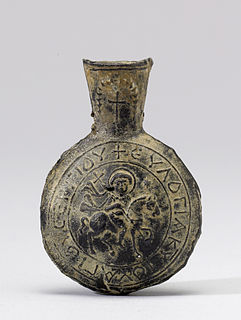 W
WThe Monza ampullae form the largest collection of a specific type of Early Medieval pilgrimage ampullae or small flasks designed to hold holy oil from pilgrimage sites in the Holy Land related to the life of Jesus. They were made in Palestine, probably in the fifth to early seventh centuries, and have been in the Treasury of Monza Cathedral north of Milan in Italy since they were donated by Theodelinda, queen of the Lombards,. Since the great majority of surviving examples of such flasks are those in the Monza group, the term may be used to cover this type of object in general.
 W
WA mosaic is a pattern or image made of small regular or irregular pieces of colored stone, glass or ceramic, held in place by plaster/mortar, and covering a surface. Mosaics are often used as floor and wall decoration, and were particularly popular in the Ancient Roman world.
 W
WByzantine mosaics are mosaics produced from the 4th to 15th centuries in and under the influence of the Byzantine Empire. Mosaics were some of the most popular and historically significant art forms produced in the empire, and they are still studied extensively by art historians. Although Byzantine mosaics evolved out of earlier Hellenistic and Roman practices and styles, craftspeople within the Byzantine Empire made important technical advances and developed mosaic art into a unique and powerful form of personal and religious expression that exerted significant influence on Islamic art produced in Umayyad and Abbasid Caliphates and the Ottoman Empire. In addition, Byzantine mosaics went on to influence artists in the Norman Kingdom of Sicily, in the Republic of Venice, and, carried by the spread of Orthodox Christianity, in Bulgaria, Serbia, Romania and Russia. In the modern era, artists across the world have drawn inspiration from their focus on simplicity and symbolism, as well as their beauty.
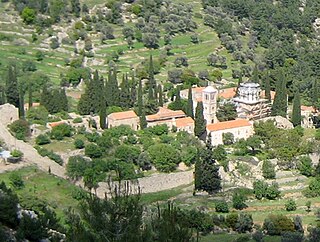 W
WNea Moni is an 11th-century monastery on the island of Chios that has been recognized as a UNESCO World Heritage Site. It is located on the Provateio Oros Mt. in the island's interior, about 15 km from Chios town. It is well known for its mosaics, which, together with those at Daphni and Hosios Loukas, are among the finest examples of "Macedonian Renaissance" art in Greece.
 W
WThe Nemanjić dynasty is depicted in a family tree composition in several specimen of Byzantine art frescoes in medieval Serbian Orthodox monasteries. The scheme is known as the Nemanjić family tree. Examples include those of Gračanica (1321), Peć, Visoki Dečani, and Matejić.
 W
WThe term Norman-Arab-Byzantine culture, Norman-Sicilian culture or, less inclusively, Norman-Arab culture, refers to the interaction of the Norman, Latin, Arab and Byzantine Greek cultures following the Norman conquest of Sicily and of Norman Africa from 1061 to around 1250. The civilization resulted from numerous exchanges in the cultural and scientific fields, based on the tolerance showed by the Normans towards the Greek-speaking populations and the Muslim settlers. As a result, Sicily under the Normans became a crossroad for the interaction between the Norman and Latin Catholic, Byzantine-Orthodox and Arab-Islamic cultures.
 W
WOur Lady of Perpetual Help is a Roman Catholic title of the Blessed Virgin Mary as represented in a celebrated 15th-century Byzantine icon also associated with the same Marian apparition.
 W
WThe Painted Churches in the Troödos Region is a UNESCO World Heritage Site in the Troödos Mountains of central Cyprus. The complex comprises ten Byzantine churches and monasteries richly decorated with Byzantine and post-Byzantine murals:Church of Agios Nikolaos tis Stegis in Kakopetria: An 11th-century monastery and the oldest surviving katholikon in Cyprus Agios Ioannis Lampadistis Monastery in Kalopanagiotis: A 13th-century monastery Church of Panagia Phorviotissa (Asinou) in Nikitari: A 12th-century church Church of Panagia tou Arakou in Lagoudhera: A 12th century church Church of Panagia in Moutoullas: A 13th-century chapel and the earliest example of steep-pitched wooden roofs Church of Archangelos Michael in Pedoulas: A late 15th-century church Church of Timios Stavros in Pelendri: A church containing unique 14th-century wall paintings Church of Panagia Podithou in Galata: An early-16th century church Church of Stavros Agiasmati in Platanistasa: A 14th-century church Church of Agia Sotira tou Soteros in Palaichori Oreinis: A 16th-century church.
 W
WPala d'Oro is the high altar retable of the Basilica di San Marco in Venice. It is universally recognized as one of the most refined and accomplished works of Byzantine enamel, with both front and rear sides decorated.
 W
WPammakaristos Church, also known as the Church of Theotokos Pammakaristos, is one of the most famous Greek Orthodox Byzantine churches in Istanbul, Turkey. Adapted in 1591 into the Fethiye Mosque, it is today partly a museum, the parekklesion. The edifice serves as one of the most important examples of Constantinople's Palaiologan architecture, and the last pre-Ottoman building to house the Ecumenical Patriarchate. It also has the largest amount of Byzantine mosaics in Istanbul after the Hagia Sophia and Chora Church.
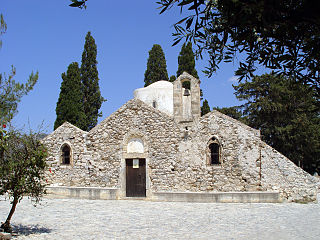 W
WThe Church of Panagia Kera is a Cretan Byzantine church, located 1 km from the village of Kritsa, in the Dikte Mountains. It contains the finest-preserved Byzantine-era frescoes in Crete, and for that reason, has become one of the most culturally and historically significant churches on the island.
 W
WThe Preslav Treasure was found in autumn of 1978 at the vineyard in Castana, 3 km to the north - west of the second Bulgarian capital – Veliki Preslav. The excavations that followed revealed more than 170 golden, silver and bronze objects including 15 silver Byzantine coins belonging to Constantine VII, Romanos II and other artifacts dating far back to the period between 3 rd and 7 th centuries.
 W
WThe Rubens vase is a Late Antique or early Byzantine hardstone carving of a single piece of agate in the form of a vase, named after a later owner, Peter Paul Rubens,, who in Flanders made a pen drawing of it, which is now held in the Hermitage Museum. It is believed to have been commissioned by a Byzantine emperor, perhaps around 400 AD, and made in Constantinople. That it appeared in Europe after the Sack of Constantinople by the Fourth Crusade, may indicate that it was the result of plunder. After passing through the collections of the Dukes of Anjou, Charles V, Peter Paul Rubens, and the Mughal Emperor Jahangir, it was eventually purchased by Henry Walters.
 W
WThe Basilica of Saint Praxedes, commonly known in Italian as Santa Prassede, is an ancient titular church and minor basilica located near the papal basilica of Saint Mary Major, on Via di Santa Prassede, 9/a in rione Monti of Rome, Italy. The current Cardinal Priest of Titulus Sancta Praxedis is Paul Poupard.